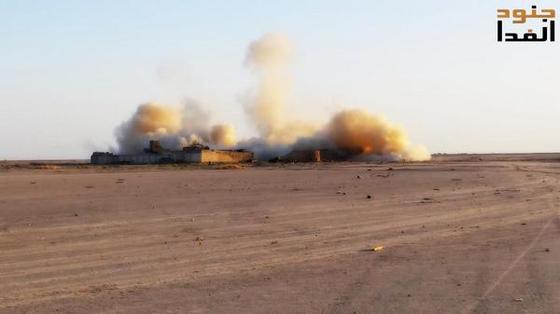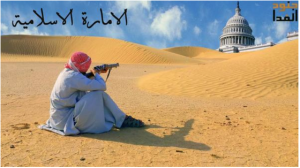Between Oct. 7 and Oct. 11, the US military orchestrated a large-scale operation against two al Qaeda camps in the southern Afghan province of Kandahar. Dozens of jihadists were reportedly killed during the raids.
One of the two camps was so big that it covered almost 30 square miles, an indication that al Qaeda’s presence in Afghanistan is far more significant than US officials have claimed in the past.
The jointly conducted raids targeted a pair of camps in the Shorabak district in Kandahar, according to a US military statement that was obtained by The Long War Journal. More than 200 US troops and Afghan commandos launched the operation after months of advanced planning.
The statement quoted Brigadier General Wilson Shoffner, a US military spokesman, who said the US and its ally had carried out “one of the largest joint ground-assault operations we have ever conducted in Afghanistan.” The two camps were hit with 63 airstrikes, which provided cover for ground forces.
General Shoffner’s description of the facilities indicates that they had been built long ago. “The first site, a well-established training camp, spanned approximately one square mile. The second site covered nearly 30 square miles,” Shoffner said. “We struck a major al Qaeda sanctuary in the center of the Taliban’s historic heartland,” Shoffner added.
According to the statement, “numerous” al Qaeda fighters were killed, but an exact number has not been disclosed. On Oct. 10, a spokesman for Afghanistan’s interior ministry tweeted that 100 terrorists were killed and 50 more injured.
The US military said that a “large media cell” was broken up at one of the sites and a cache of weapons was seized during the raid. Although the military did not identify the members of the “media cell,” they likely belong to As Sahab, al Qaeda’s official propaganda arm. Jihadists on social media have said that As Sahab relocated its operations into Afghanistan over the past year.
The haul recovered at the camps reportedly includes “heavy weapons, IED-making material and other valuable intelligence data including foreign passports, laptops and associated IT media, digital cameras and cards, documents, and mobile phones.” In addition, the US and its Afghan allies seized “anti-aircraft weapons,” “rocket-propelled grenade systems with associated hardware and warheads,” “machine guns, pistols, rifles and ammunition.”
General Shoffner characterized the operation as an “enormous success” that “validates our ongoing campaign.”
“Working with, by, and through our Afghan partners, we’re building their capabilities while we fight our common enemies,” he continued. Shoffner added that the “goal of the operation was to degrade the terrorist network in Afghanistan.”
Junood al Fida, a Baloch jihadist group, operates in Shorabak and Reg districts
At least one al Qaeda-affiliated group is known to operate in the Shorabak district, as well as the neighboring Reg district of Kandahar.
Last year, both the Taliban and an organization named Junood al Fida claimed to have successfully pushed Afghan forces out of the Reg district. The Taliban said at the time that the Afghans fled into Shorabak. Junood al Fida, which is openly loyal to al Qaeda emir Ayman al Zawahiri and the Taliban, posted a series of photos on its official Twitter feed from the attacks. [See LWJ report, Jihadist group loyal to Taliban, al Qaeda claims to have captured Afghan district.]
In a statement released in July 2014, Junood al Fida described Zawahiri as “Our Shaykh al Habeeb” [beloved leader] and “Ameeruna” [our chief]. Junood al Fida’s hostility to the US was highlighted throughout the message. Its members had “migrated to areas in southern Afghanistan to wage jihad against the United States and the ‘US puppets’ in Afghanistan,” the statement read. “As for the United States’ future in Afghanistan,” Junood al Fida threatened, “it will be fire and hell and total defeat, God willing, as it was for their predecessors – the Soviets and before them, the British.” An image (seen on the right) released by the group via Twitter showed one of its fighters pretending to take aim at the US Capitol building.
In early August 2014, Junood al Fida, which draws fighters from Baluchistan, eulogized one of its commanders. The eulogy described Abdul Hafeez (also known as Maulvi Abu Baseer) as “a well-known commander” in the Zabul, Helmand and Kandahar provinces of the Taliban’s emirate in Afghanistan. The statement also indicated that Abdul Hafeez had waged jihad for decades, going back to the Soviets’ days in Afghanistan.
Beginning in May 2014, Junood al Fida released several videos of its operations in the Shorabak district and nearby areas. The videos show the jihadists targeting Afghan forces and checkpoints.
Al Qaeda operating throughout Afghanistan
The US military has not answered an obvious question: How did al Qaeda establish two training camps along the Afghan-Pakistan border in a province that is supposedly secure from the Taliban?
Before his death, Osama bin Laden ordered al Qaeda operatives to relocate from Pakistan’s tribal areas back into Afghanistan. The move ensured that al Qaeda would outlive the US drone campaign, which successfully killed dozens of top al Qaeda figures. Al Qaeda also moved some of its infrastructure, including training camps, into Afghanistan.
Even before bin Laden’s order to relocate, al Qaeda was known to run training facilities in Afghanistan. Al Qaeda has hosted camps in the northern district of Baghran in Helmand province. Hundreds of Taliban and al Qaeda fighters rotated through the Baghran camps, which were run by the Shadow Army, US officials told The Long War Journal in 2009. It is unclear if the Taliban and al Qaeda still train in the district. However, Baghran is believed to be still under the Taliban’s control. The Shadow Army, or the Lashkar al Zil, is al Qaeda’s paramilitary force and fights alongside the Taliban and other jihadist groups in Afghanistan and Pakistan. [See LWJ report, Al Qaeda’s paramilitary ‘Shadow Army’.]
Al Qaeda is also known to run training camps and maintain bases in Kunar, using the province to direct operations in the Afghan east. A dual-hatted Taliban and al Qaeda military commander known as Qari Zia Rahman oversees training camps that are used to indoctrinate and train females, including children, to carry out suicide attacks on both sides of the Afghan-Pakistani border. ISAF has targeted several bases and camps in Kunar over the past several years. [see LWJ report, ISAF captures al Qaeda’s top Kunar commander, for more details].
Al Qaeda allies such as Harakat-ul-Mujahideen (HUM) and Lashkar-e-Taiba have training camps in the eastern Afghan provinces of Kunar and Nuristan as well. As late as August 2014, the US government said that HUM, an al Qaeda and Taliban-linked jihadist group based in Pakistan, has training facilities in Afghanistan.
“HUM also operates terrorist training camps in eastern Afghanistan and has conducted a number of operations against Indian troops and civilian targets in the Kashmir region,” the US State Department said in its update to HUM’s foreign terrorist organization designation in August 2014. The Long War Journal confirmed in a follow-up inquiry with State that the HUM camps in eastern Afghanistan are still in operation. The exact number and location of the camps has not been disclosed.
The Turkistan Islamic Party, a Uighur jihadist group closely allied to al Qaeda, also advertised a training camp in Afghanistan earlier this year.
The US military’s raid in Shorabak contradicts two important claims that have been repeatedly made by both the Obama administration and the US military. First, US officials have argued that al Qaeda is primarily confined to Kunar and Nuristan. The latest US-led operations show this claim is false. Second, US officials have said that al Qaeda has only a small number of fighters, some 50 to 100, in all of Afghanistan.
Kandahar is far from Kunar and Nuristan, and the two large camps described by the military would likely have dozens of staff and trainees, if not far more.
More than 14 years after the Sept. 11, 2001 terrorist attacks, al Qaeda retains a significant footprint in Afghanistan. Al Qaeda’s importance within the Taliban-led insurgency was underscored in August, when the new Taliban emir, Mullah Akhtar Mohammad Mansour, publicly accepted Zawahiri’s oath of allegiance. Indeed, the Taliban’s leadership is closely allied with al Qaeda.










6 Comments
Fighting a “war” in fits and starts. What a joke! Months of preparation. Two-hundred U.S. soldiers. Sixty-three airstrikes. One-hundred enemy dead? Really? Two camps, one of which is almost 30 square miles, and only 100 enemy dead? In 63 airstrikes? Surely, that was a typo? It was 36, right? Tell me, it was 36. If 63 is correct, that’s roughly 1.6 enemy/airstrike. Did the Afghan commandos and U.S. soldiers shoot anybody? Was the months of preparation just waiting for 100 of these guys to get in a 30 square mile area? The real casualties of this “war” are the American taxpayer. Repugnant!
The presidential team could not have possibly believed this wasn’t going to happen. As his actions in Iraq proved this very same plot would play out.
For the thousands of men and women who served over there and died, thousands more wounded, sacrifices made.
Treasuries spent to tribal leaders who turned on us. He says none of what they did being erased in less than a year watching your enemies now with all our weaponry. I know, he makes all the hard decisions.
It would be interesting to get a no-BS assessment of the current state of the ANSF, as far as what they are competent at, what needs improvement, etc. Thoughts?
It is assuredly encouraging to see these serious strikes against AQ training camps. It would have been particularly useful to have relentlessly attacked camps like al Farouq in the late 1990’s with the same intensity, but that is not much more than gratuitous hindsight.
There is an inconvenient truth, however, in this reporting and at least 5 other stories covered in the LWJ today. While the media coverage, and arguably the USG’s overall focus, remains preoccupied with the Islamic State, al Qaeda is resilient and rebuilding. Abu Sayyaf, once assigned a role for 9/11 attacks on the west coast, remains well-entrenched and well-financed in the Philipines. AQIM remains active in North Africa, and its affiliates
have largely weathered the French assaults in Mali. AQAP has an even stronger foothold in Yemen. Certainly many dozens of well-trained AQ fighters have infiltrated France and western Europe through the refugee onslaught. Time is on their side.
It is unfortunately a largely unchallenged assumption that al Qaeda is somehow in demise, eclipsed by the Islamic State’s impressive media and recruiting strengths. We would do well to remember the guidance of Sun Tsu and give our enemies the benefit of the doubt.
There have been several serious attacks on al-Baghdadi; when is the last time you have heard of a credible attack upon al Zawahiri?
Al Qaeda’s elusive leadership continues to call for attacks in the west and against the United States. This period is beginning to hauntingly resemble the late 1990’s when we were criminally indifferent to a wealth of pre-attack indicators. The Long War Journal remains the only reputable resource that consistently portrays the jihadist world as it is and will continue to be.
I like the picture of the guy shootin at the Capitoal surrounded by sand dunes. Reminds me of Charlton Heston in the last scene of Planet of the Apes where he’s pounding sand
I don’t know if we have any AC-130H gunships still in the country but that would
seem to be an ideal mission for one or two of them… a large dispersed area full of
AQ folks.